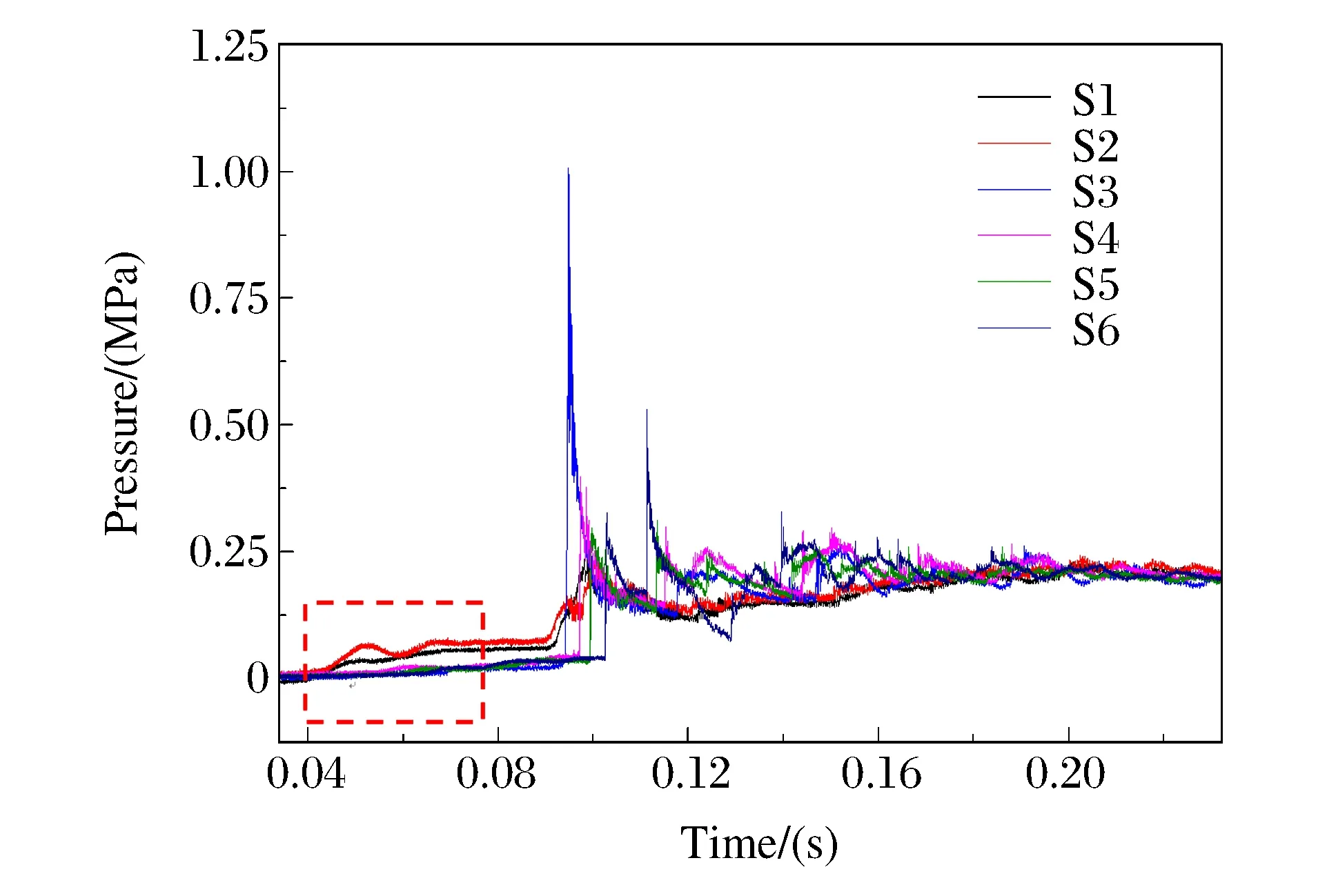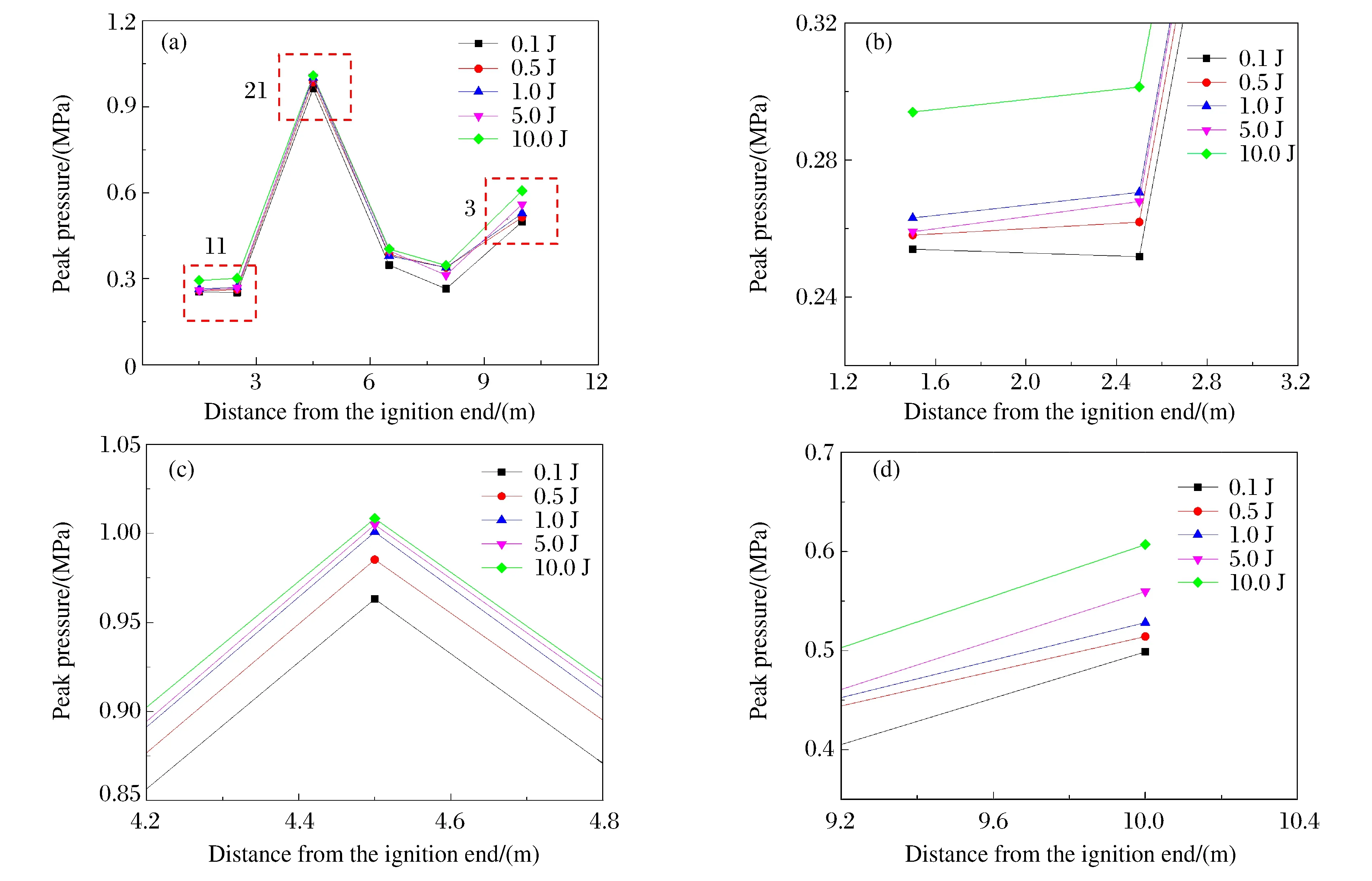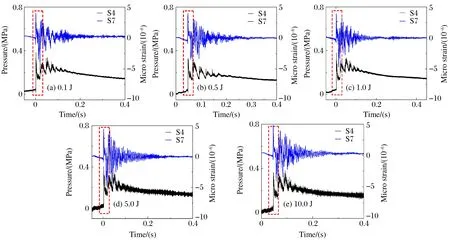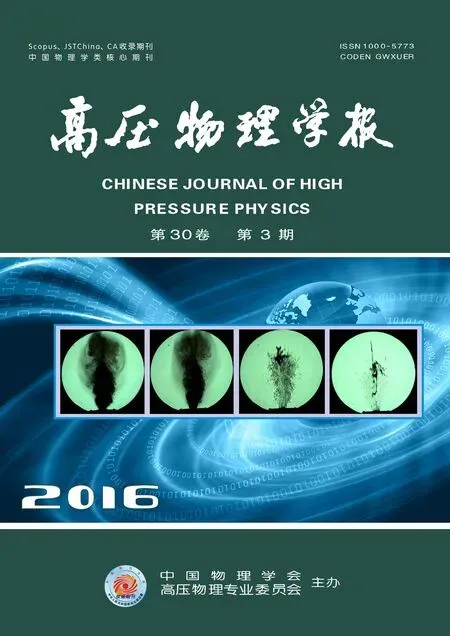点火能对气体爆炸过程中薄壁管道应变规律的实验研究
周 宁,耿 莹,冯 磊,刘 超,张冰冰
(常州大学油气储运技术省重点实验室,江苏常州 213016)
1 Introduction
The application of combustible gas is more and more widely practiced in recent years,and it comes with the gas leak explosion,which is becoming more and more frequent and the consequences are rather serious.Therefore,many scholars have done wide-ranging and effective work on the characteristics of combustible gas explosion in a confined space and have achieved certain results.
Zhouetal.[1]studied experimentally on the accelerated motion law and influencing factors of the deflagration flame in a straight pipe by setting an accelerator ring.They analyzed the influence of the piping diameter,the ignition energy and the obstacles on the flame acceleration in the pipeline.Thomasetal.[2]studied on the interference effects of the incident and reflected shock waves on the explosion flame.The result shows that,in many cases,the incident and reflected shock waves could accelerate flame propagation obviously.This result had been verified by Gamezoetal.[3]through theoretical derivation.Luetal.[4]studied the premixed flame acceleration in a closed pipeline,thinking that the flame acceleration is due to the unburned gas before the flame front heated by the precursor compression wave and the positive feedback caused by turbulence.Besides,the characteristics of flame propagation change with the concentration of combustible gas.Fairweatherletal.[5]came to a conclusion that “pipeline explosion overpressure is mainly due to turbulence generated by the obstacles”,through numerical simulation on gas explosion flame propagation in detonation tube.Currently,however,there are relatively few studies on the impacts of ignition energy on the characteristics of combustible premixed gas explosion in a confined tube.Meanwhile,when blast waves in a sealed gas pipeline meet with connecting elements,e.g.,the flame arrester,reflected waves will be produced back and forth,and the research on the dynamic response of reflected waves to the pipe is limited.From the microcosmic point of view,when affected by the mixed gas explosion pressures,the pipeline will result in a certain degree of deformation,which is called strain.So we need to explore the relationship between the explosion pressure and the thinned-wall pipe strain.Because precursor shock waves and reflected waves existing in the explosion process have effects on explosion pressures and thinned-wall pipe strain,it is necessary to explore whether there is a correlation between them.Based on safe design and safe operation of the long-distance pipeline,this paper carried out a preliminary study on premixed gas explosion pressures and thin-walled dynamic strain in the closed pipe with different ignition energies.
2 The Experimental System and Scheme
2.1 Experimental Device
The configuration under study consists of an experimental pipeline system,a gas distribution system,test systems,auxiliary facilities,etc.The test pipe is a seamless stainless steel pipe,with an inner diameter of ∅0.125 m,an outer diameter of ∅0.130 m,a wall thickness of 0.002 5 m,the total length of 12 m and the maximum designed pressure of 5 MPa.The gas distribution system includes air compressors,gas cylinders and gas tanks with premixed gas configured by the volume/pressure ratio method.The test system includes a data acquisition system,sensors,an ignition device,EPT-6,and an ultra-dynamic strain gauge (SDY2107A),which is a kind of dynamic resistance strain gauges with self-balancing.The igniter can adjust ignition energy from 0.1 to 10.0 J.Auxiliary facilities include air compressors,vacuum pumps,valves,etc.Related equipment and testing system installations are shown in Fig.1.

1.Ignition electrode,2.Igniter,3.Premix gas tank,4.Compressor,5.Methane gas cylinders,6.Visual window,7.Data logger 8.Monitor Fig.1 Sketch map of experimental setup
2.2 Arrangement of Sensors
Sensors are arranged to study the explosion pressure propagation law and the dynamic response of the thin-walled pipe.From the beginning of the firing end,a total of six pressure sensors and two groups strain sensors are placed.Due to the obstacles placed in the pipeline from 2.5 to 4.0 m to the ignition electrode,pressure sensors are arranged as shown in Fig.2.At the same time,the S7 strain sensor and S8 strain sensor are arranged in the S4 and S5 pressure sensor position,to explore the relationship between explosion pressure and thin wall pipeline dynamic strain in the same location.The number of each sensor and the distance to the ignition side are shown in Table 1.Thinking that the strain generated in this experiment platform is rather small,we chose semiconductor strain gauges whose sensitivity are about 54 times greater than that of ordinary resistance strain gauges,when monitoring the pipeline hoop strain at a specific location.

Fig.2 Arrangement diagram of sensors

SensorNo.SensortypeDistancefromthefiringend/(m)SensorNo.SensortypeDistancefromthefiringend/(m)S1Pressure1.0S5Pressure8.0S2Pressure2.5S6Pressure10.0S3Pressure4.5S7Strain6.5S4Pressure6.5S8Strain8.0
2.3 Experimental Parameters and Scheme
Experiments were carried out at room temperature and atmospheric pressure in the closed tube,which is sealed by a stainless blind plate.9.2% methane-air premixed gas should be configured before the experiments,and then standing for some time,at last,be used to measure the explosion pressure and strain values when the ignition energy is 0.1,0.5,1.0,5.0 and 10.0 J.In order to obtain more obvious thin-walled load characteristics,this experimental study placed a series of obstacles constituted by 12 annular steels whose blocking rate is 60% in the pipeline,and set the distance between the ignition electrode and the first steel at 2.5 m and the spacing of adjacent annular steels at 0.15 m.
To reduce the possible experimental error,our group carried out 5 parallel experiments under each working condition,and then analyzed the average value of the experimental data.
3 Results and Analysis

Fig.3 Measured pressures versus time history
3.1 Analysis of Measured Pressures
Fig.3 shows a set of data collected by the pressure sensors from individual channels.We set the point where the explosion pressure increases suddenly as the take-off point.It should be noted that after 0.04 s the explosion pressures rise slowly,which may be caused by the spark discharge,so these points cannot be set as take-off points.
Fig.4(a) shows the variation trend of peak pressures measured by pressure sensors at different locations in various ignition energy conditions.We can see that the peak pressure variation trends are almost consistent.The larger the ignition energy,the greater the maximum peak pressure measured.Furthermore,Fig.4(a) shows that peak pressures increase suddenly at 2.5 m,and then reach the maximum at 4.5 m.At the same time,the rising rate of the explosion peak pressures at this segment is the largest of all.As we all know,the rising rate of explosive peak pressures is the criterion for measuring the combustion speed,which is also the criterion for measuring explosion intensity.Apparently,within this range,the power of the gas explosion is the most dramatic because,when meeting the obstacles placed in this segment,the precursor pressure waves produced shock waves.Since then,the turbulence formed by the interaction of the shock waves and the subsequent flame front accelerated the flame propagation,enhanced the explosion pressures and strengthened the influence of the precursor shock waves which,in turn,heated and compressed the unburnt gas before the flame front and further resulted in greater turbulence.This is the positive feedback mechanism about the precursor pressure wave compression and heating effect on unburned gas.Fig.4(b) obtained by enlarging the block 1 in the Fig.4(a) illustrates that at the distance from the ignition end between 1.5 to 2.5 m,the larger the ignition energy,the greater the measured peak pressure.This is because there was no obstacle disposed within the segment,and the larger ignition energy,the greater chemical energy released,thereby the greater measured peak pressure.Fig.4(c) obtained by enlarging the block 2 in the Fig.4(a) illustrates that the larger the ignition energy,the greater the maximum peak pressure.Particularly,for 0.1,0.5 and 1.0 J,the magnitude of the maximum peak pressure increase is bigger.In addition,the measured peak pressures after 4.5 m suddenly drop.It is precisely because the precursor shock waves reached the closed end at first,and then produced the reflected shock waves.When interacting with the flame front,the reflected shock waves produced a larger reverse flow velocity,which hindered the flame propagation and lowered the peak pressures.When reaching the ignition end,the new shock waves reflecting back accelerated the flame propagation,and the peak pressures measured by sensors after 8 m appeared to rise again.Fig.4(d) obtained by enlarging the block 3 in the Fig.4(a) clearly shows that the measured peak pressures at S6 increase along with the increasing of the ignition energy.

Fig.4 Measured peak pressures versus distance history under different ignition energy
In general,the larger the ignition energy,the greater the chemical energy released and the measured peak pressure.Thereby,the abilities of accelerating flame propagation again and resisting hindering the flame propagation will be stronger,especially for 1.0,5.0 and 10.0 J.The above data analyses illustrate that ignition energy plays a significant role in the process of the flame propagation.
3.2 Analysis of the Strain in the Thin-Walled Pipeline
The strain sensors are composed of two semiconductor strain gauges pasted symmetrically on both sides of the pipe wall at 6.5 and 8.0 m,used to measure the circumferential strain.The biggest advantage of the semiconductor strain gauge is its higher sensitivity.In addition,due to the small mechanical hysteresis,the transverse effect and its small size,once the wall stress changes,the resistance strain gauge will produce deformation simultaneously,which then changes the resistance and voltage.In this experiment,the strain gauges were constituted as Strain Bridge,amplified by super dynamic instrumentation and then transmitted to the data acquisition instrument.The experiment adopted a series of interference prevention methods,such as the super dynamic strain gauge,bridge box and grounding wire being set connected at the same point.
Considering the inquiry point of this paper that exploring the relationship of explosion pressures and thin-walled dynamic strain which placed in same location,S7 channel is taken as the example.Fig.5(a),Fig.5(b),Fig.5(c),Fig.5(d) and Fig.5(e) show respectively the pressure-time curves at S4 and the thin-walled strain-time curves at S7 measured at the distance 6.5 m from the ignition end under the ignition energy for 0.1,0.5,1.0,5.0 and 10.0 J.From these figures we can see the thin-walled strain positive and negative alternately.It is because detonation products and gas expansion due to the blast shock waves kept pipe swelling for a long time until the shock waves and detonation products ceased functioning.Finally,due to inertia,the closed pipe vibrated freely,which induced periodic expansion and contraction.The dynamic strain signals and the pressure wave signals in the blocks have a good consistency.At the same time,the choppy signals behind the blocks suggest that waves reflecting back and forth at both ends of the closed tube superimposing constantly have a loading effect on the thin wall.

Fig.5 Pipeline pressure signals and thin-walled strain signals under different ignition energy
In conclusion,in the whole explosion process,the thin-walled strain at first increased suddenly resulting from the precursor shock wave,and then appeared to vibrate for a long time which induced by the reflected wave back and forth.Due to the depletion of explosives and the wane of the reflecting wave,chemical energy was all converted into heat and the pipeline’s exploding and compressing ceased.Eventually,the pipe did not produce deformation and the strain became zero.
Fig.5 shows that the maximum values of the thin-walled micro strain in different ignition energy conditions were all caused by the precursor shock waves.Although the micro strain fluctuated by the superimposition effect of the waves reflecting back and forth on both ends of the pipeline,it decreased in volatility,due to the energy loss of the tube wall heat.By calculation,when the ignition energy is respectively 0.1,0.5,1.0,5.0 and 10.0 J,the corresponding maximum micro strain is 3.89,3.91,3.99,4.45 and 4.83.Obviously,the larger the ignition energy,the greater the chemical energy released.The precursor shock waves have a greater impact on the flame propagation and can induce a bigger maximum thin-walled micro strain.So,the study on the effect of the ignition energy on the dynamic strain of the thin wall has significant research meaning for pipeline safety design.
4 Conclusions
This study focuses on measuring premixed gas explosion characteristics in the closed pipeline and researching the effects of the ignition energy on explosion severity.The main results are summarized as follows.
(1) The larger the ignition energy,the greater the chemical energy released and the maximum peak pressure.Thereby,the abilities of accelerating flame propagation again and resisting hindering the flame propagation will be stronger,especially for 1.0,5.0 and 10.0 J.
(2) In the whole explosion process,the thin-walled strain at first increased suddenly as a result of the precursor shock wave,and then appeared vibrating for a long time which was induced by the wave reflecting back and forth.Due to the depletion of explosives and the wane of the reflecting wave,the chemical energy was all converted into heat and the pipeline’s exploding and compressing ceased.In addition,there is a good consistency between the dynamic strain signals and the pressure wave signals.
(3) The maximum value of the thin-walled micro strain is caused by the precursor shock wave in the entire process.Moreover,the larger the ignition energy,the greater the precursor shock wave influence,which eventually induces the larger maximum of the thin-walled micro strain.
[1] 周凯元,李宗芬.丙烷-空气爆燃波的火焰面在直管道中的加速运动 [J].爆炸与冲击,2000,20(2):137-142.
ZHOU K Y,LI Z F.Flame front acceleration of propane-air deflagration in straight tubes [J].Explosion and Shock Waves,2000,20(2):137-142.
[2] THOMAS G,BAMBREY R,BROWN C.Experimental observations of flame acceleration and transition to detonation following shock-flame interaction [J].Combust Theor Model,2001,5(4):573-594.
[3] GAMEZO V N,KHOKHLOV A M,ORAN E S.Effects of wakes on shock-flame interactions and deflagration-to-detonation transition [J].Proc Combust Inst,2002,29(2):2803-2808.
[4] 卢 捷,宁建国,王 成,等.煤气火焰传播规律及其加速机理研究 [J].爆炸与冲击,2004,24(4):305-311.
LU J,NING J G,WANG C,et al.Gas flame propagation and acceleration mechanism [J].Explosion and Shock Waves,2004,24(4):305-311.
[5] FAIRWEATHER M,HARGRAVE G K,IBRAHIM S S,et al.Studies of premixed flame propagation in explosion tubes [J].Combust Flame,1999,116(4):504-518.
[6] 丁以斌,肖福全,宣晓燕,等.立体结构障碍物的不同放置方式对甲烷预混火焰传播影响的研究 [J].煤炭学报,2012,37(1):137-140.
DING Y B,XIAO F Q,XUAN X Y,et al.Deposited manner of solid structure obstacles influence on flame propagation in premixed-methane tube [J].Journal of China Coal Society,2012,37(1):137-140.
[7] 潘鹏飞,谭迎新,王志青.条形障碍物对瓦斯爆炸特性影响研究 [J].中国安全生产科学技术,2010,6(5):71-76.
PAN P F,TAN Y X,WANG Z Q.Study on effects of strip-type obstacles on methane explosion [J].Journal of Safety Science and Technology,2010,6(5):71-76.
[8] 徐进生,刘 洋,陈先锋,等.甲烷与空气质量浓度当量比对火焰结构及传播特性的影响 [J].中国安全与科学,2015,25(1):64-69.
XU J S,LIU Y,CHEN X F,et al.Effect of concentration of methane and air equivalence ratio on flame structure and propagation characteristics [J].China Safety Science Journal,2015,25(1):64-69.
[9] IBRAHIM S S,MASRI A R.The effect of obstructions on overpressure resulting from premixed flame deflagration [J].J Loss Prevent Proc,2011,14(3):213-221.
[10] 林柏泉,洪溢都,朱传杰,等.瓦斯爆炸压力与波前瞬态流速演化特征及其定量关系 [J].爆炸与冲击,2015,35(1):108-115.
LIN B Q,HONG Y D,ZHU C J,et al.The evolution characteristics and quantitative relation of gas explosion pressures and the wave front transient velocity [J].Explosion and Shock Waves,2015,35(1):108-115.
[11] 程关兵,李俊仙,李书明,等.氢气/丙烷/空气预混气体爆轰性能的实验研究 [J].爆炸与冲击,2015,35(2):249-254.
CHENG G B,LI J X,LI S M,et al.Experimental study on detonation performance of hydrogen gas/propane/air premixed gas [J].Explosion and Shock Waves,2015,35(2):249-254.

